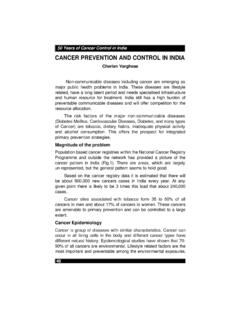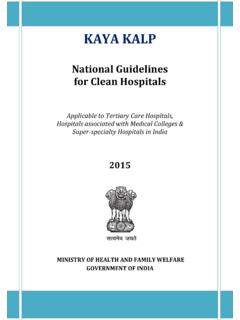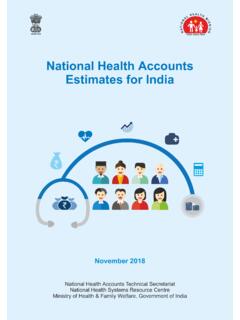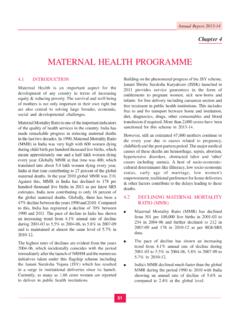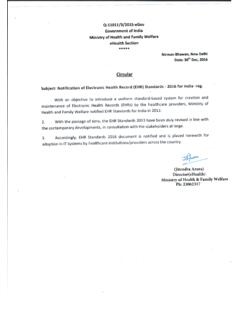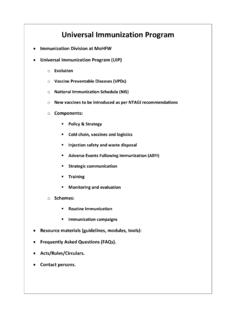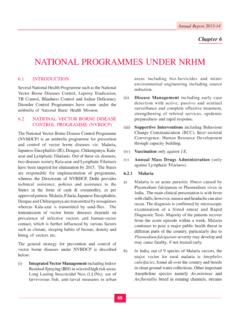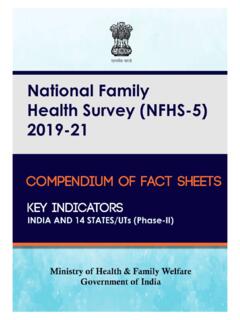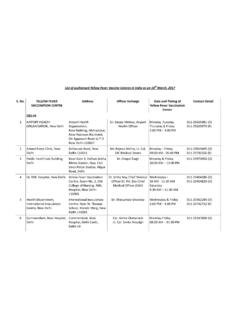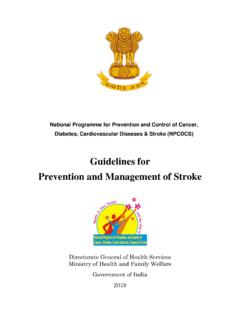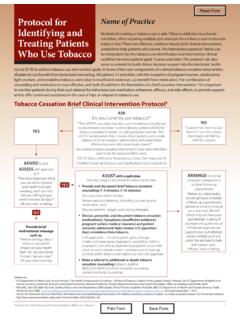Transcription of NATIONAL PROGRAMME FOR PREVENTION AND CONTROL …
1 1 NATIONAL PROGRAMME FOR PREVENTION AND CONTROL OF CANCER, DIABETES, CARDIOVASCULAR DISEASES & STROKE (NPCDCS) OPERATIONAL GUIDELINES (REVISED: 2013-17) Directorate General of health Services Ministry of health & Family welfare Government Of India 2013 2 1. POLICY & STRATEGIC FRAMEWORK FOR IMPLEMENTATION Introduction In 2008, out of the 57 million global deaths, 36 million deaths, or 63%, were due to NCDs, principally cardiovascular diseases, diabetes, cancers and chronic respiratory diseases. Nearly 80% of NCD deaths occur in low-and middle-income countries.
2 It is projected that globally NCDs will account for nearly 44 million deaths in 2020. The leading causes of NCD deaths in 2008 were: cardiovascular diseases (17 million deaths, or 48%of NCD deaths); cancers ( million, or 21% of NCD deaths); respiratory diseases, including asthma and chronic obstructive pulmonary disease (COPD), ( million) and diabetes ( million deaths).NCDs kill at a younger age in low- and middle-income countries, where 29% of NCD deaths occur among people under the age of 60, compared to 13% in high-income countries. (Global status report on non-communicable diseases 2010) In India, the estimated deaths due to NCDs in 2008 were million (World health Organization - NCD Country Profiles, 2011).
3 The overall prevalence of diabetes, hypertension, Ischemic Heart Diseases (IHD) and stroke in India is , , and respectively per 1000 population. (Indian council for Medical Research, 2006). Based on NATIONAL Cancer Registry PROGRAMME (NCRP) of Indian Council of Medical Research (ICMR), it is estimated that there are about 28 lakh cases of different type of Cancers in the country with occurrence of about 11 lakh new cases and about 5 lakh deaths annually. The common cancers are breast, cervical and oral cancer. Major risk factors to NCDs Most NCDs are strongly associated and causally linked with following four major behaviour risk factors: tobacco use Physical inactivity Unhealthy diet including high intake of salt, Sugar & Transfats and low intake of fruits & vegetables Harmful use of alcohol The other risk factors include stress and household air pollution.
4 If the above behavioural risk factors are not being managed /modified then they may lead to following biological risk factors: Over weight/obesity High blood pressure Raised blood sugar 3 Raised total cholesterol/lipids The other non-modifiable risk factors such as age, sex and heredity are also associated with the occurrence of NCDs. States implementing NPCDCS have already initiated some of the activities for PREVENTION and CONTROL of non-communicable diseases (NCDs) especially cancer, diabetes, CVDs and stroke. The Central Government is supplementing their efforts by providing technical ,financial and logistics support through NATIONAL Program for PREVENTION and CONTROL of Cancer, Diabetes, CVD and Stroke (NPCDCS).
5 The Government of India launched a flagship PROGRAMME called the NHM in 2005 with the objective of expanding access to quality health care to rural populations by undertaking architectural corrections in the institutional mechanism for health care delivery. The crucial strategies under NHM have been the integration of Family Welfare and NATIONAL Disease CONTROL Programmes under an umbrella approach for optimization of resources and manpower; strengthening of outreach services by incorporation of village health worker called ASHA; efforts for communitization of services through formation of health and Sanitation Committees at village, block and district level; registering Rogi Kalyan Samities for improving hospital management.
6 Strengthening and upgrading the public health infrastructure to Indian Public health Standards (IPHS); and consolidation of the District Level PROGRAMME Management Unit through the induction of professionals. On 1st May 2013, NATIONAL Urban health Mission (NUHM) was launched as a Sub-mission of an over-arching NATIONAL health Mission (NHM), with NATIONAL Rural health Mission (NHM) being the other Sub-mission of NATIONAL health Mission. The NPCDCS aims at integration of NCD interventions in the NHM framework for optimization of scarce resources and provision of seamless services to the end customer / patients as also for ensuring long term sustainability of interventions.
7 Thus, the institutionalization of NPCDCS at district level within the District health Society, sharing administrative and financial structure of NHM becomes a crucial PROGRAMME strategy for NPCDCS. The NCD cell at various levels will ensure implementation and supervision of the PROGRAMME activities related to health promotion, early diagnosis, treatment and referral, and further facilitates partnership with laboratories for early diagnosis in the private sector. Simultaneously, it will attempt to create a wider knowledge base in the community for effective PREVENTION , detection, referrals and treatment strategies through convergence / linkage with the ongoing interventions of NATIONAL health Mission (NHM) including NATIONAL tobacco CONTROL PROGRAMME (NTCP), NATIONAL Mental health PROGRAMME and NATIONAL PROGRAMME for health Care of Elderly (NPHCE) for NCDs and convergence with other programmes dealing with (i) communicable diseases like TB,(ii) RCH, (iii)
8 Adolescent /School health build a strong 4 monitoring and evaluation system through the public health infrastructure. Objectives of NPCDCS health promotion through behavior change with involvement of community, civil society, community based organizations, media etc. Opportunistic screening at all levels in the health care delivery system from sub-centre and above for early detection of diabetes, hypertension and common cancers. Outreach camps are also envisaged. To prevent and CONTROL chronic Non-Communicable diseases, especially Cancer, Diabetes, CVDs and Stroke.
9 To build capacity at various levels of health care for PREVENTION , early diagnosis, treatment, IEC/BCC, operational research and rehabilitation. To support for diagnosis and cost effective treatment at primary, secondary and tertiary levels of health care. To support for development of database of NCDs through Surveillance System and to monitor NCD morbidity and mortality and risk factors. Strategy health promotion, awareness generation and promotion of healthy lifestyle Screening and early detection Timely, affordable and accurate diagnosis Access to affordable treatment, Rehabilitation During the 12th FYP, while the coverage is proposed to be pan India, the focus of the PROGRAMME is on health promotion, PREVENTION , detection, treatment and rehabilitative services at decentralized level up to district hospital under the overall umbrella of NATIONAL health Mission for primary and secondary level health care services.
10 The PROGRAMME division at the NATIONAL level will develop broad guidelines and strategy for implementation of different components of the PROGRAMME . The States may adopt and modify these guidelines as per their need and circumstances for implementation of the PROGRAMME . Involvement of community, civil society and private sector partnership would be vital, and suitable guidelines would be made for the same. health Promotion Given that the major determinants to hypertension, obesity, high blood glucose and high blood lipid levels are unhealthy diet, physical inactivity, stress and 5 consumption of tobacco and alcohol, awareness will be generated in the community to promote healthy life style habits.
